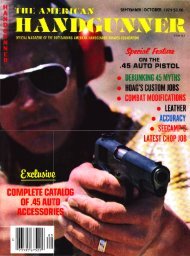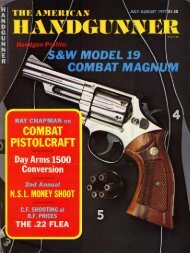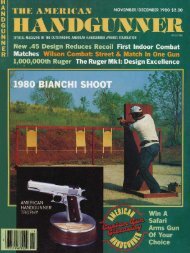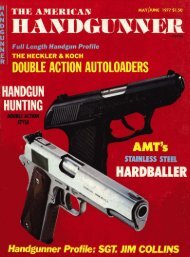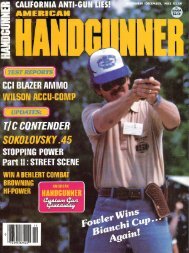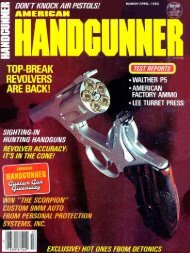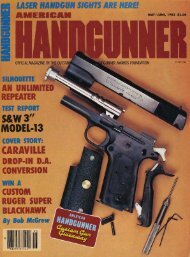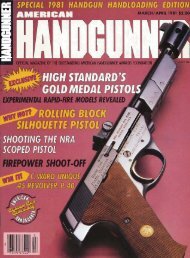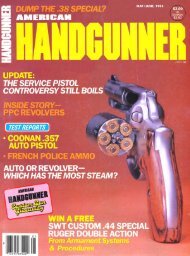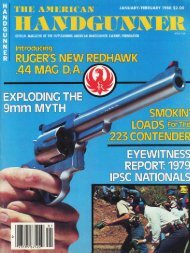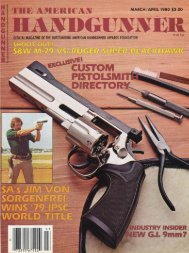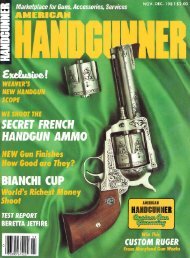American Handgunner July/August 1982
American Handgunner July/August 1982
American Handgunner July/August 1982
You also want an ePaper? Increase the reach of your titles
YUMPU automatically turns print PDFs into web optimized ePapers that Google loves.
The Brown Precision Stock when smootfJed up, drilled out and painted is ready to shoot.<br />
provide a flat surface to rest against your<br />
calf. (Those stocks that have fat or flared<br />
butts, such as the nylon number, perch OJ;l<br />
that high point, and require you to cock<br />
the pistol to get your fingers to touch the<br />
thigh, and the normally-found rounded<br />
forearm shape provides little contact surface<br />
on the sloping calf and slides down.)<br />
Subtle touches, but useful aids to shooting<br />
top scores.<br />
The stock shoots as good as it looks. I<br />
slipped my 8mm IHMSA into the one I got<br />
to test, and with the aid of my Siebertmodified<br />
6X Leupold pistol scope<br />
(converted from an 12XAO) I shot several<br />
three-quarter to one:inch groups with my<br />
hunting load while getting ready for a Wyoming<br />
antelope hunt.<br />
Chet Brown's Mid-Grip<br />
The problem of fitting the stock to the<br />
shooter's hand has been addressed in a direct<br />
fashion with a new stock from Brown<br />
Precision Company (P.O. Box 270W, Los<br />
Molinos, CA 96055). Chet Brown was one<br />
of the first to build fiberglass stocks and<br />
was also probably one of the first to hear<br />
complaints that his stock didn't fit the<br />
shooter's hand. Hands, as you might expect,<br />
vary in size and shape and satisfying<br />
everyone with one handle is an impossible<br />
task. What you'd have to do is mold the<br />
handle to fit each hand, and that's what<br />
Chet has done.<br />
Chet now offers a version of his regular<br />
mid-grip stock with an undersized peg for<br />
a handle that comes with a bottle ofepoxy<br />
resin and a bag oflightweight filler. The intention<br />
is that the shooterI gunsmith bed<br />
the pistol's action in the stock in the usual<br />
fashion, and then bed the pistol to the<br />
shooter's hand.<br />
The catalysed resin and filler are mixed<br />
together into as stiff compound as possible<br />
and then the goo is spread over the peg.<br />
The shooter, with a generous coating ofrelease<br />
agent on the appropriate hand, grips<br />
the goo and assumes the favored shooting<br />
position. Depending upon the temperature<br />
and drops of catalyst added, in ten to<br />
fifteen minutes the shape of the hand has<br />
been permanently committed to epoxy<br />
44<br />
and hopefully, has solidified in the<br />
required position and angle on the pistol.<br />
When me memorialized my hand we<br />
added too much resin and the goo was<br />
fluid enough that, even though I tried to<br />
hold the correct position, I shifted my wrist<br />
angle enough so that when I shot the<br />
smoothed up stock I found that it bitjust as<br />
bad as the factory version. 0 big deal I<br />
figured, I'll just mold some more.<br />
Eventually, I got the stock to a very comfortable<br />
level using Duratite wood dough.<br />
A lightweight epoxy putty would be better<br />
than the goo; it wouldn't be so apt to shift,<br />
but I don't know of any such.<br />
Unfortunately, the wood dough overgrossed<br />
the stock, and even after a liberal<br />
drilling and a change to an aluminum<br />
cocking piece of the action, the complete<br />
pistol was an ounce over weight. Barrel's<br />
too heavy, I guess.<br />
Still, the stock fits so well. It'll be my<br />
hunting stock for my 8mm IHMSA pistol,<br />
and with my custom converted 6X Leupold<br />
long-eye-relief scope, will be useful<br />
on the prairie and on the rifle silhouette<br />
range (those 220 grain Sierra at 2000 fps do<br />
generate some recoil) when we set out to<br />
show the rifle shooters who's the best.<br />
McMillan Prototype<br />
A new approach to shooting that elusive<br />
straight has been taken in an experimentaf<br />
stock built by Gale McMillian. (Box DY<br />
72, Cave Creek Stage, Phoenix, AZ 85020.)<br />
Gale has been building fiberglass-reinforced<br />
epoxy-resin rifle stocks for<br />
benchrest shooters and other riflemen interested<br />
in the benefits of synthetic stocks<br />
for sometime. This past last year, he's had<br />
time to turn his talents to pistol stocks for<br />
XP-IOO based unlimited guns. He's currently<br />
molding conventional mid-grip<br />
stocks, using either graphite or fiberglass<br />
fi.eer reinforcement, but at the request of a<br />
shooting friend built a front-grip stock.<br />
The stock is ambidextrous, and utilizes<br />
some exotic fibers to provide the necessary<br />
strength between grip and action while<br />
maintaining the thin shell construction<br />
necessary to produce a lightweight stock.<br />
Gale's intention was to save as much<br />
weight as possible in the stock, so the extra<br />
weight could be put to better use in the<br />
barrel to provide increased rigidity and<br />
safety.<br />
Today's unlimited pistols are assembled<br />
with the care and quality of a lightweight<br />
benchrest and are capable ofa straight any<br />
day, but the targets are still tiny and the<br />
shooter must cope with iron sights, a less<br />
than solid hold and variations in point of<br />
impact induced by changes in grip pressure.<br />
What Gale has done is to recognize the<br />
human factor in the process of sending a<br />
bullet down range. Accomplishing this requires<br />
developing a different kind ofpistol<br />
stock, one that is designed as a complimentary<br />
part of the shooter/pistol/ammo<br />
system.<br />
The primary discriminator between<br />
those who shoot 40s every match and the<br />
rest of us is eyesight. The limitations posed<br />
by open, iron sights were soon noticed by<br />
the early competitors and the solution<br />
many turned to was to install the iron sight<br />
rifleman had long ago developed to eliininate<br />
these problems: the peep sight. Unfortunately,<br />
they overlooked the human<br />
factor. The peep sight just doesn't work at<br />
an arms length from the eye. Fired from a<br />
supine position, the self-centering action<br />
of an aperture close to the eye is lost and<br />
the rear sight is reduced to being a circular,<br />
open notch that must "be consciously<br />
aligned with the front sight. Fired prone,<br />
the eye-to-sight distance is reduced, but<br />
not enough to change things ifthe conventional<br />
rear or mid-grip pistol is kept a safe<br />
distance from the face.<br />
The design solution to the eyesight<br />
problem is the same one everybody else<br />
has tried, the peep sight, but the approach<br />
selected moves the peep to the proper<br />
distance from the eye, so that the aperture<br />
is effective. This is accomplished by moving<br />
the sight rearward in relation to the<br />
grip and by having the shooter fire prone.<br />
Control of the pistol in recoil, even with a<br />
full length .308, can be achieved by using a<br />
locked elbow hold with the shooting arm.<br />
Use ofa cartridge of modest recoil, such as<br />
AMERICAN HANDGUNNER· JULY/AUGUST <strong>1982</strong>



